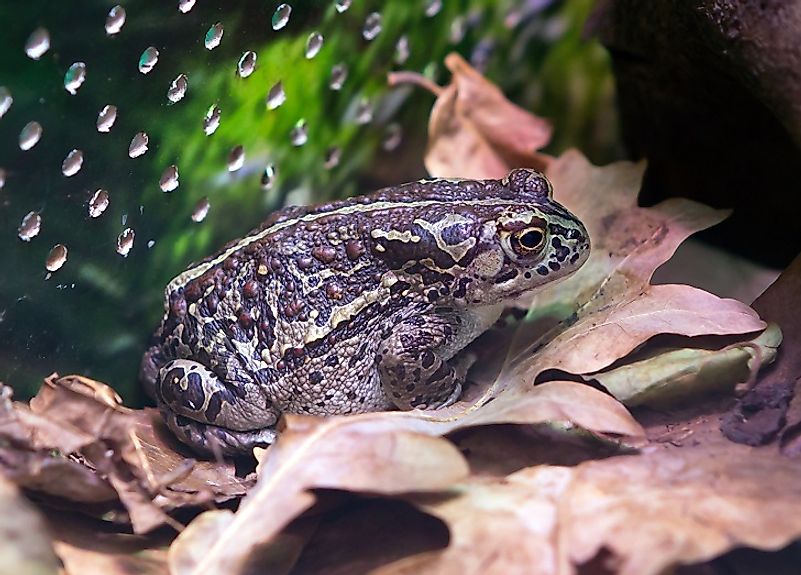The Amphibians Of Mongolia

Mongolia is a landlocked country in East Asia bordering China to the south and Russia to the north.The Mongol ethnic group makes up 96% of the national population. The country experiences freezing winters where temperatures reach -30 Degrees Celsius and relatively warmer summers. Forests cover 12% of the nation. Mongolia is widely known for its history in conserving animals. Notable amphibians found in the region include the Japanese tree frog, Mongolia toad, Khabarovsk frog, Asiatic grass frog, and Siberian salamander.
Japanese Tree Frog
The scientific name is Hyla Japonica and this frog is mostly found in rice paddies and on broad leaves, especially rice leaves, during the daytime. It differs from the common tree frog as the Japanese frog has a dark spot on the upper lip and has slightly shorter hind legs. It has a granular ventral skin and smooth dorsal skin. The tips of fingers and toes have round adhesive discs with the forelimb webbing being poorly developed. The species are found in Japan, Korea<Mongolia, and Russia. Hibernation takes place from October to May on land. Individual frogs take refuge in leaf litters, holes in trees and under the rocks. Reproduction occurs in warm water in May-August. The males get into the water before the females and make a mating call which happens both day and night. The females lay up to 1500 eggs in water. The average lifespan is eight years.
Mongolian Toad
The dorsal skin is light olive with large dark spots. The belly is light gray with few dark spots. Males are relatively larger as compared to females and have a guttural resonator used for storing air while calling. They have a horizontal eye pupil. The toads are commonly found in China, Korea, Russia, and Mongolia. Mongolian toads hibernate in groups from October to May. During the winter the hibernation occurs in very deep holes. The female lays up to 6000 eggs in strings of around six meters in length. If reproduction is done in shallow waters, high mortality of tadpoles occurs.
Siberian Salamander
The Siberian Salamander is bluish-brown in color with a purple stripe running along the back. It has a longer tail than its body. This salamander has a body which is highly adapted to long freezing temperatures with an example of one which survived for years at temperatures below -45 Degrees Celsius and eventually walked off upon thawing. However, sudden frost has proven to be problematic since it needs time to produce “anti-freezing “chemicals that replace water from cells to protect them from damage by sharp ice crystals. The exact mechanism that the salamander uses is not known. The amphibian lives in diverse habitats from aquatic, terrestrial, forest, grassland, and wetlands. On average, the female lays 240 eggs in a season with four weeks incubation period. Scientists are conducting research to make antifreeze for food, medical supplies and also adventure seekers caught up in frost from the antifreeze capability of the Siberian Salamander.
Asiatic Grass Frog
The scientific name is Rana chensinensis, and it is classified under the Ranidae Family. Its natural habitats include temperate forests, rivers, intermittent rivers, swamps, freshwater lakes, arable land, pastureland and irrigated land. It is commonly found in China and Mongolia. It is threatened by habitat loss. The Chinese breed these frogs for their excellent performance on preying pests. Qinyuan County in China in the year 1982 found that breeding the frogs reduced both the use of pesticides and the pollution in the environment. Locals hunt the frogs for making Hasma, a dessert, and traditional medicine. It is made from the fatty tissue found close to the frog’s fallopian tubes.
Khabarovsk Frog
The Khabarovsk frog is unable to survive in areas with elevations exceeding 2,000 feet. It is also not resistant to habitat disturbances. On top of that, Russians have been known town to hunt the frog actively and thus faces a serious threat of habitat loss. However, on a global scale, it is not considered as threatened. The frog favors’ beetles and eats only 0.0055 pounds of food per day. It has a lifespan of three years on average.
The Amphibians Of Mongolia
| Native Amphibians of Mongolia | Scientific Name |
|---|---|
| Japanese Tree Frog | Hyla japonica |
| Mongolian Toad | Pseudepidalea raddei |
| Khabarovsk Frog | Rana amurensis |
| Asiatic Grass Frog | Rana chensinensis |
| Siberian Salamander | Salamandrella keyserlingii |







